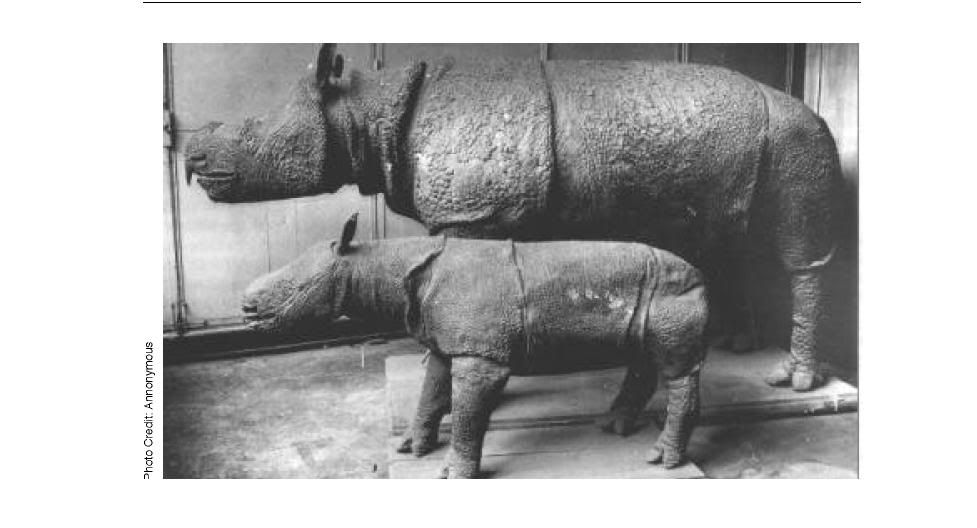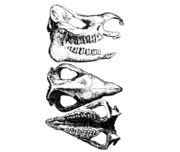|
|
Post by sebbe67 on Nov 3, 2005 19:02:17 GMT
Subspecies of the Javan rhino Once inhabited India (as far west as West Bengal), Bangladesh and Burma. It is not known when it did become extinct. Likely extinction reason is extensive habitat lost and illegal hunting. www.iucn.org/themes/SSC/sgs/AfESG/pachy/pachy24.html |
|
|
|
Post by sebbe67 on Nov 3, 2005 19:05:28 GMT
third subspecies (Rhinoceros sondaicus inermis) once occurred in eastern India and adjacent regions of the Asian mainland, but is now extinct.
|
|
|
|
Post by sebbe67 on Nov 3, 2005 19:08:10 GMT
inermis means without horn (which migt point on a subspecies with tiny horns) - the type specimen was a female.
|
|
|
|
Post by sebbe67 on Nov 3, 2005 19:15:01 GMT
The Javan rhinos existed in the forests near the Bay of
Bengal, called the Sundarbans, in southern Bangladesh
and the state of West Bengal, India. It was first shot by
F.V. Lamarepicquot in 1828, whose two specimens were
described as a new species, Rhinoceros inermis, by
Lesson in 1838. The animal was noted in the Sundarbans
with some regularity until 1892. In total 11 specimens
are known in different museums. The rhinos lived in
small numbers in well-defined localities throughout the
entire Sundarbans. It must have become extinct before
1925.
|
|
|
|
Post by sebbe67 on Nov 3, 2005 19:15:56 GMT
INTRODUCTION
The Javan rhino (Rhinoceros sondaicus Desmarest,
1822) today has a severely restricted range with very
low numbers. It is easily the most endangered species
of rhino. However, in the last century it roamed much
wider, from the Indonesian islands of Java and Sumatra,
northwards to Malaysia, Thailand and Burma. It is also
likely that most records of rhinos from Laos, South
Vietnam, and southern Cambodia pertain to this singlehomed
species (Rookmaaker, 1980 and 1988). On the
western side it extended to the northeastern states of India
and into northern Assam, and in the Sunderbans of
Bangladesh and India (Rookmaaker, 1984). The records
concerning the existence of the Javan rhino in the
Sunderbans have never been collected and an attempt is
made here to map the extent of the animal’s range in
these forests.
The Sundarbans or Sunderbunds is a name for the tidal
swamp forest formed by the estuary of the Ganges, on
the sea-front of southern Bangladesh and the adjoining
part of the Indian state of West Bengal. It is an area of
islands surrounded by small creeks, covered by dense
forest, daily flooded by the tidal currents. Swamp deer
(Cervus duvauceli) and wild buffalo (Bubalus bubalis)
have disappeared from the area, but it is still inhabited
by larger land mammals like axis deer (Axis axis), wild
pig (Sus scrofa) and tiger (Panthera tigris), known to
be dangerous man-eaters (De, 1990; Chakrabarti, 1992).
It would not be a habitat where one would immediately
expect a rhino, as elsewhere in the world it is rare to
find this animal in estuarine forests with limited supply
of fresh water. The occurrence of the single-horned
Javan rhino (Rhinoceros sondaicus Desmarest, 1822) in
the Sundarbans, however, is established beyond doubt,
and the animal is thought to belong to a separate
subspecies, R. s. inermis Lesson, 1838. While there are
a few early records, almost all available information
pertains to the 19th century, and it is believed that the
rhino must have become extinct in the area during the
first decades of the 20th century.
The northern edge of the Sundarbans is just a few hours
travel from Calcutta or from Dhaka, but still the area
was seldom visited. It required substantial preparations
to take enough water and food for several days, a boat
was essential, and few braved the heat, the mosquitoes
and the fear of man-eating tigers. To most sportsmen in
India of the 19th century, who only looked for game in
their spare time, the Sundarbans was hardly a favourite
destination, generally not deemed to be worth the trouble.
Still, a few people recorded how they encountered rhinos
in the Sundarbans, and the present paper will try to
summarize who saw the animal at which places. The
area has so many waterways and islands, that it is a
nightmare to a cartographer, hence there is an absence
of good maps. Most of the names mentioned in the
available reports cannot be found on modem maps,
which is a serious obstacle in reviewing the occurrence
of the Sundarbans rhino.
|
|
|
|
Post by sebbe67 on Nov 3, 2005 19:16:51 GMT
At the end of the 1 8th century, Thomas Pennant
published an elaborate account of a totally imaginary
tour through India. When he reached the Sundarbans,
he noted that ‘the one-horned rhinoceros is very common
in these islands, it loves forests and swampy places’
(Pennant, 1798). Apparently his authority for the
existence of rhinos in this region was ‘a gentleman of
my acquaintance’, who Pennant (1793) elsewhere
identified as Charles Pigot, of Peploe, Shropshire, at that
time in the Indian service. Mr Pigot had landed on an
island and ‘roused a rhino, which rushed on him, flung
him down, and ripped open his belly; the rhino proceeded
without doing him any further injury; the gentleman
survived the wound, and lived to a very advanced age
(Pennant, 1798). It must be realised, partly from this
story, that every ship of the Dutch, French and British
East India Companies trying to reach their stations along
the Ganges had to pass the Sundarbans. One could
suggest (but not prove) that when in those early days
people mentioned rhinos in India or Bengal, they might
have actually referred to the Javan species rather than
the Great Indian rhino (Rhinoceros unicornis L., 1758).
There are three earlier reports of rhinos in the
Sundarbans. Around 1630, Sebastien Manrique passed
the island Xavaspur (point 7 in Figure 1), in the estuary
of the Meghna River, and ‘came across many Rhinos,
whose horns, offensive in life, are after their death used
in a defensive drug’ (Manrique, 1927). On 16 January
1664, the Dutchman Wouter Schoutens (1 676) passed
the River Jillisar [?], where the shores of the Ganges are
covered with bushes, inhabited by rhinos and other
animals. Another traveler, Thomas Bowrey (1905)
visited the ‘creeks and rivolets at or about the entrance
into the ganges’ around 1670 and mentioned the presence
of ‘rhinocerots’ besides tigers and bears.
|
|
|
|
Post by sebbe67 on Nov 3, 2005 19:17:06 GMT
Table 1. Records of rhinos in the Sundarbans in chronological order. The map reference refers to the numbers on
Figure 1.
Map Locality Date and Collector Source Section
7 Island 1630 Manrique 1927 Early Reports
Xavaspur
? River Jillisar 1664 Schoutens 1676 Early Reports
Sundarbans 1670 Bowrey 1905 Early Reports
Sundarbans 1828, Berlin Museum Eastern Sunderbans;
Lamarepicquot Naturkunde der
Humboldt - Universitat-
No I and 2
2 Saugor Island, 1832 Shekarea 1832 Western Sunderbans
Middleton (India)
Point
4 Baugundee, 1834, J.H. Barlow Calcutta Museum Calcutta, Indian
Jessore district Museurn - No. 2
Sundarbans 1850, C.Huffnagle Calcutta Museum Calcutta, Indian
Museum - Museum No. I
1 Pealee River, c. 1850 Baker 1887 South of Calcutta
near B arrapoor
6 Eastern part of c. 1850 Baker 1887 Eastern Sunderbans
Sundarbans (Bangladesh)
Sundarbans 1859, A. Grote London Museum London, Museum of
the Royal College of
Surgeons of England - No. 1
6 Foolzurree, 1860 Simson 1886 Eastern Sunderbans
S.of (Bangladesh)
Backergunge
Sundarbans 1867, W.W.Shepperd Calcutta Museum Calcutta, Indian Museum No. 5
Sundarbans 1872, J.F. Barckley Calcutta Museum Calcutta, Indian Museum No. 4
Sundarbans 1874, O.L.Fraser Calcutta Museum Calcutta, Indian
and J.E Barckley Museum No. 3
Fraser 1875
6 Matabangah 1875 Calcutta Museum Calcutta, Indian
River, Barisal Museum No. 6
district
3 Ray Mangal 1876, Jamrach Sclater 1876 Western Sunderbans (India)
River
Sundarbans 1876 London Museum London, Natural History
Museum - No. I
Sundarbans 1877, Jamrach Sclater 1877 Western Sunderbans (India)
? Chillipang / 1879, Capt.Charling Calcutta Museum Calcutta, Indian
Chillipangpi Museum - No. 7
Sundarbans 1888 De 1990 Discussion
(one killed)
5 R.Pizon Khalee. 1892 de Poncins 1935 Eastern Suderbans (Bangladesh)
S.Issuripore
Sundarbans 1900 Shebbeare 1953 Discussion
(one seen)
Sundarbans 1908 Hussain 1985 Discussion
|
|
|
|
Post by sebbe67 on Nov 3, 2005 19:18:41 GMT
|
|
|
|
Post by another specialist on Nov 3, 2005 19:59:33 GMT
thanks for the link sebbe67 one very interesting pdf file - nice image of stuffed specimens
|
|
|
|
Post by chinadavid on Nov 29, 2005 2:53:11 GMT
China Rhinoceros sp (arguement rages about the vakidity of R, sinensis). reports from Zhejiang 6000bp & Hemudu 7000bp & more recently from near Nanning in Guangxi 2500bp, extinct in Yunnan last 300 yrs with one book suggesting last fifty years.
David Ewbank
|
|
|
|
Post by another specialist on Nov 29, 2005 23:38:54 GMT
thanks for the link sebbe67 one very interesting pdf file - nice image of stuffed specimens  |
|
|
|
Post by another specialist on Nov 29, 2005 23:43:02 GMT
thanks for the link sebbe67 one very interesting pdf file - nice image of stuffed specimens  |
|
peej2
Full Member
  
Posts: 118
|
Post by peej2 on Mar 5, 2006 18:04:51 GMT
Is there anymore photographs of perserved museum specimens of the extinct subspecies of javan rhinoceros or sumatran rhinoceros?
|
|
|
|
Post by another specialist on Mar 5, 2006 18:06:52 GMT
Is there anymore photographs of perserved museum specimens of the extinct subspecies of javan rhinoceros or sumatran rhinoceros? Not that i know of and can find on web |
|
|
|
Post by sebbe67 on Nov 4, 2007 22:57:26 GMT
 Female Javan rhino imported by the animal dealer Jamarch from the Sunderbunds (Bangladesh). It was in London in 1877 where it lived less than 6 months. From Sclater 1877. www.rhinoresourcecenter.com |
|
|
|
Post by another specialist on Nov 5, 2007 19:21:25 GMT
The three-subspecies model of Guerin & Groves (1980) and Groves & Chakraborty (1983) seems to be supported by this analysis. At any rate. Rhinoceros sondaicus inerrnis, the extinct Sunderbans form, was thoroughly distinct from all others. more info on rhinos here www.rhinoresourcecenter.com/ref_files/1178937328.pdf |
|
|
|
Post by another specialist on Aug 14, 2008 10:36:35 GMT
  Bibliography of the Rhinoceros By L. C. Rookmaaker |
|
|
|
Post by Peter on Jun 10, 2012 8:14:51 GMT
|
|
|
|
Post by surroundx on May 7, 2015 9:30:16 GMT
|
|
|
|
Post by Sebbe on Apr 10, 2019 18:26:34 GMT
|
|